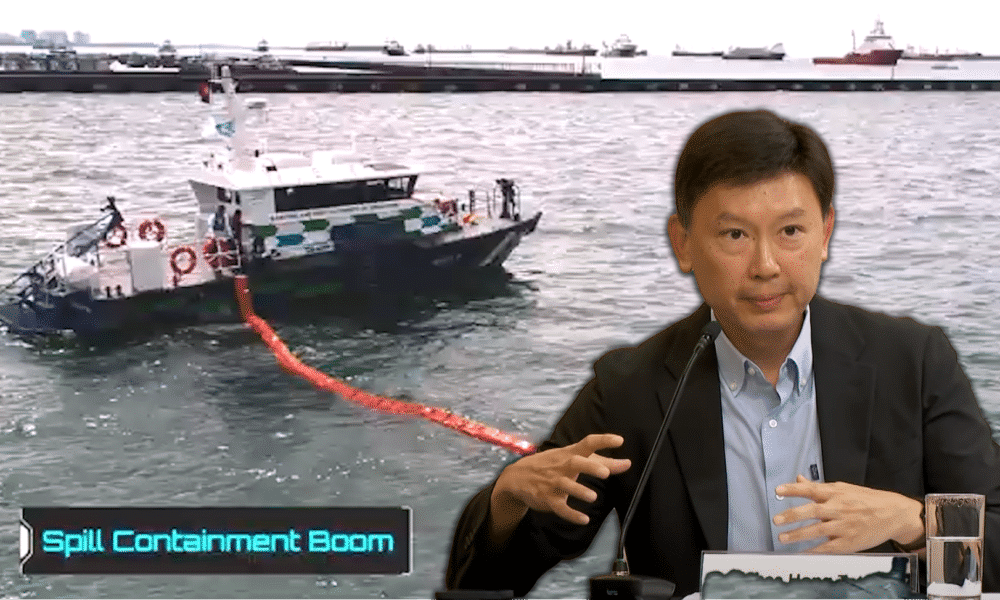During a press conference on 24 June on the oil spill from the Singapore-flagged bunker vessel Marine Honour after a Netherlands-flagged dredger struck it on 14 June, Transport Minister Chee Hong Tat explained that deploying containment booms were not meant to “fence in” the spilt oil but rather served as a preventive measure against any further spillage from the damaged vessel.
This was in response to questions from a reporter about why there was no initial information in the first press release on 14 June regarding the possible spread of the oil, which led to some surprise among the public when oil washed ashore later.
The reporter also queried the Minister whether there is room for improvement in the deployment time of containment booms during such oil spills, given the critical need for a quick response.
Mr Chee defended the response times of the Maritime and Port Authority of Singapore (MPA) and its contractor, T&T Salvage Asia, stating that they adhere to international industry standards.
He emphasized that upon discovering the oil spill, the immediate priority was to prevent further leakage from Marine Honour. This involved ensuring the vessel’s stability and safety, securing the crew, and halting any ongoing oil release from the damaged tank.
“Because if you have oil that continues to come out in large amounts from the vessel, I think that will make the situation even worse,” he stated. He emphasized the urgency of promptly applying dispersants to prevent the oil from hardening, which would complicate cleanup efforts both at sea and on land.
The first MPA patrol craft arrived 11 minutes after the incident at 2:33 pm to spray dispersants in the water.
Following the initial response operations, at 2:55 pm, MPA contacted T&T Salvage Asia to deploy containment booms around the damaged bunker vessel.
Mr Chee said the team from T&T Salvage required several hours to load the heavy equipment and additional time to sail to the site. Their boat arrived at the site at 9:41 pm.
They completed laying 200m of booms around Marine Honour at 5:15 am on 15 June – nearly 15 hours after the incident.
He explained that the deployment process can be time-consuming due to various factors such as weather conditions (daytime versus nighttime operations) and the logistical challenge of handling a spill of this scale.
“Deploying the containment boom around the damaged vessel will take several hours, including the time for the vessel to arrive at the incident site and the time taken to fully deploy the booms,” said Mr Chee.
“During this time, we must expect a significant amount of the oil that has been spilt into the sea to be carried by tidal currents and waves to other locations away from the incident site. This is unavoidable, especially during more serious oil spill incidents, like what we experienced on 14 June.” Mr Chee added that while containment booms can capture some oil near the incident site, they are not foolproof against tidal movements which can carry oil both below and above the booms.
However, Mr Chee’s statement on the purpose of setting up oil booms somewhat contradicts what he previously said back in 2020 when the MPA held a joint exercise to address oil spills and revealed the next-generation patrol craft of MPA — a S$12.2 million project which was designed and built by Penguin International.
In a report by Straits Times, it was said that the next-generation patrol craft sprung into action once they reached the scene, swiftly setting up portable water booms around the “oil spill” to prevent it from spreading, and deploying spraying systems to break up the oil particles.
The oil spill exercise enabled the new vessels, launched in August 2020, to demonstrate their ability to manage such incidents more efficiently.
For example, one such vessel is able to deploy the water booms to contain the oil spill within half an hour.
Previously, this process could have taken four to eight hours, said Mr Chee, who attended the exercise and was then Senior Minister of State for Transport and Foreign Affairs.
Speaking to the media after the exercise, he said: “That is a good first response to allow MPA, when they arrive on site, to be able to contain the oil spill before further reinforcements are called upon.”
Perhaps Mr Chee used the word “fence-in” in the press conference to avoid directly contradicting his previous statements about containing the oil spill. But seriously, is there any difference between the two terms?
As for the MPA’s next-generation patrol craft, it is puzzling why booms were not put up by the MPA patrol craft, which arrived 11 minutes after the allision of the two vessels, but instead waited for the contractor to arrive 7 hours after the incident to deploy the booms, resulting in a total of 15 hours before the oil spill could be contained on site.
This is especially surprising since booms were part of the patrol craft’s capabilities, as indicated in its tender specs in 2019 and touted in 2020.

